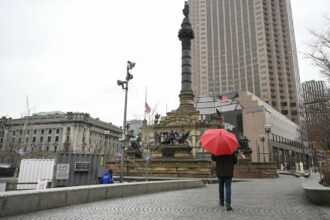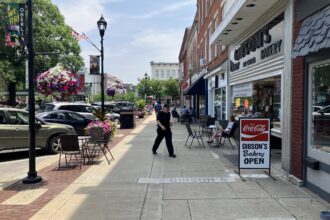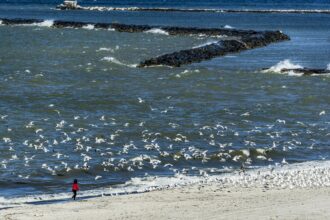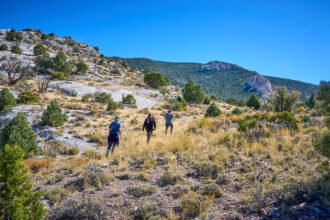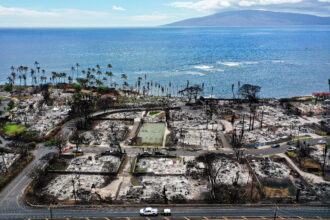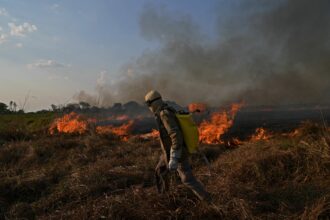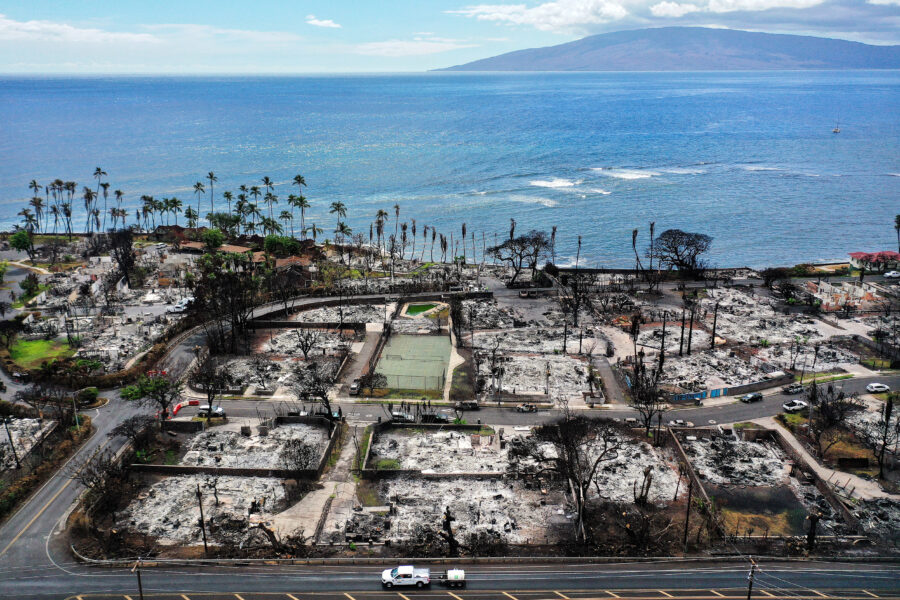CLEVELAND—Climate resiliency proposals could help reduce flooding on Cleveland’s east side while increasing recreational access to shoreline and stream areas for people in underserved communities. But, planners stress, ongoing input from underserved communities will be vital for final decisions—including whether some proposed work moves ahead at all.
“Access to fresh water and the amenities of fresh water is about equity and justice,” said Cleveland Mayor Justin Bibb in October at the Healing Our Waters – Great Lakes Coalition conference in Cleveland.
Panels addressed different proposals geared to increase access for vulnerable communities on the city’s east side. One would build up a stretch of Lake Erie coastline over a 20-year period in order to protect it. The other could restore stretches of a stream through Cleveland’s Glenville neighborhood and the nearby village of Bratenahl.
Both projects would aim to reduce problems from extreme weather linked to climate change. Data from Climate Central show Cleveland’s climate has already become warmer, wetter and wilder over the last three decades. Overall, the area has more intense rainfall and more days with heavy rainfall. Scientists anticipate those trends will continue.
Heavier rainfall and storms can erode the shoreline and cause flooding near Interstate 90, which runs along the Lake Erie coast on part of Cleveland’s east side. At times, strong waves from extreme storms splash onto I-90, which can worsen icy conditions in winter.
Flooding from extreme weather is also a problem in many neighborhoods with paved-over areas; older infrastructure there often includes combined stormwater and sanitary sewers.
CHEERS for Cleveland’s Coastline
The Cleveland Harbor Eastern Embayment Resilience Strategy, or CHEERS, would create a cove and related green space along a stretch of Lake Erie’s shoreline over the course of a 20-year period. The area sits just north of I-90, across from the site of a now-demolished FirstEnergy power plant.
The coalition working on the proposal includes Cleveland Metroparks, the Port of Cleveland, the City of Cleveland and Cleveland City Council, Black Environmental Leaders and the Ohio departments of Transportation and Natural Resources.
Cleveland continues to be a working waterfront, noted Linda Sternheimer, vice president for urban planning and engagement for the Port of Cleveland. Among other things, a federal shipping channel runs parallel to the coast slightly north of the proposed area for the CHEERS project.
“We also see our role as helping people to connect to the waterfront,” Sternheimer said. Yet large parts of Cleveland’s east side neighborhoods have been cut off from that access.
“The east side of Cleveland is where the majority of our Black and brown communities were redlined,” explained Joyce Pan Huang, Cleveland’s director of city planning. Industrial development near redlined neighborhoods often separated them from the lakefront. I-90 also cuts through the area, avoiding more well-to-do suburbs.
“The political decisions that were made decades ago impact our systems today,” said David Wilson, one of the co-directors for the Black Environmental Leaders Association and director of parks and community for LAND Studio, an arts and culture nonprofit that focuses on public spaces.
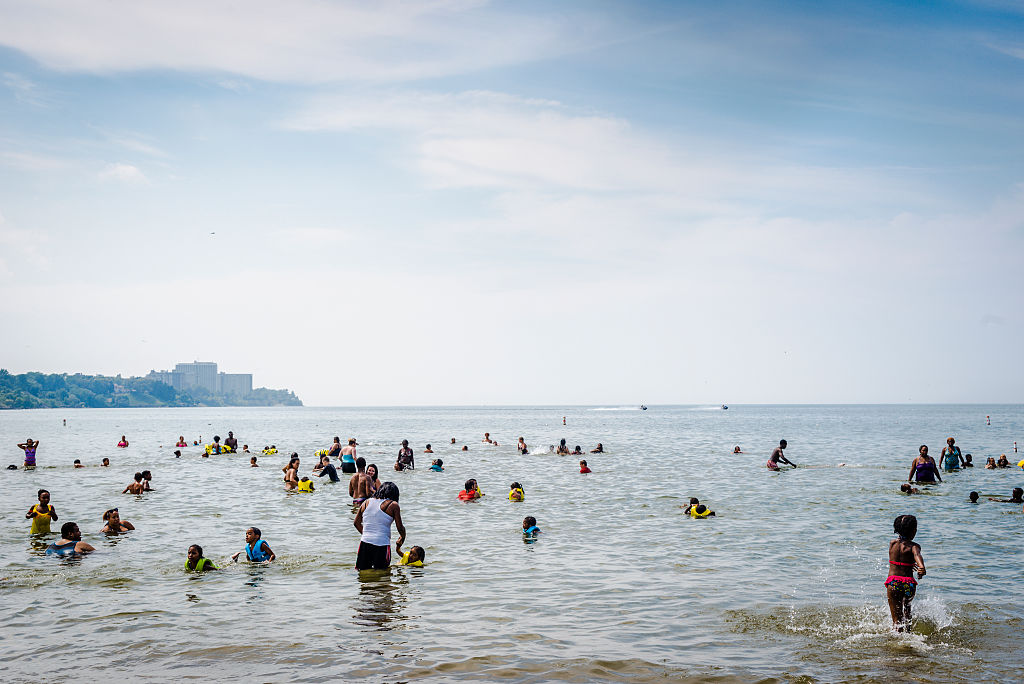
“The policies and decisions that were made in subsequent decades just have reinforced that the places that are connected to the lake are not welcoming to certain citizens,” he added. Not everyone has cars, for example, and it’s currently a challenge to walk or bike to the lake from parts of the city’s east side.
CHEERS’ current concept would use dredged material to build an artificial land area along a breakwall that extends eastward from the north edge of the marina, plus other recreational land area. Over time, that would create a cove.
The changes should reduce wave action and erosion along the current coast. Green space throughout the project area would provide educational and recreational opportunities for residents, including space for walking, picnicking, kayaking, boating and more.
Daylight for Dugway
Another proposal in its early planning stages could restore stretches of Dugway Brook. The stream feeds into Lake Erie but is mostly culverted and now channeled underground, particularly as it runs through Cleveland’s Glenville neighborhood. The stream reemerges briefly in the village of Bratenahl, north of I-90, before emptying into the lake.
The two areas were historically connected before redlining began and before I-90 was built in the mid-20th century. And Glenville still shares a zip code with part of Bratenahl, noted Pamela McClarin, co-founder and chief volunteer officer for East Cleveland Concerned Citizens.
Bratenahl now boasts lakefront properties. Its population is mostly white and has a median household income roughly twice that of Ohio as a whole. Glenville’s residents are mostly Black and have roughly half the median household income of Ohioans overall.
Flooding has become a common problem in Glenville. Currently, the first floor of the high school floods after a five-year storm, said Laura Bonnell, associate director for Chagrin River Watershed Partners, which is cooperating on the project as part of a regional collaboration effort.
A cheaper option could be to make the underground culvert larger, so it could carry more water, Bonnell said. But another option could expand connectivity and provide recreational opportunities.
“Basically, what we want to do is daylight almost 2,600 linear feet of Dugway Brook south of I-90 in the Glenville neighborhood,” Bonnell explained.
That work would create nine acres of riparian buffer, which would have the ability to slow and absorb some stormwater while also letting the stream carry a larger flow. Much of that stream length runs under a park that now has lots of plain grass area, and other publicly-owned parcels are nearby. Additionally, the project would restore 2,000 linear feet of wetland area for the brook in Bratenahl.
Earlier this year, graduate students at Cleveland State University’s Levin School of Public Affairs and Education completed a preliminary survey report on the Dugway Greenway proposal for the Chagrin River Watershed Partners and the Cleveland Foundation. McClarin was part of the team, which collected more than 100 survey responses from people in Glenville and Bratenahl.
Keep Environmental Journalism Alive
ICN provides award-winning climate coverage free of charge and advertising. We rely on donations from readers like you to keep going.
Donate NowThe responses showed substantial community interest in restoring the stream and adding recreational amenities. In addition to the environmental and recreational benefits, the Cleveland State team found the project could increase community development, attract reinvestment and expand regional connectivity.
Preliminary design work is now underway. Funding for the work comes from a $500,000 grant from the National Fish and Wildlife Foundation, a matching $500,000 grant from the Northeast Ohio Regional Sewer District (NEORSD) and nearly $76,000 of in-kind support from other community organizations.
The goal from that work will be “to get a 30 percent design and ultimately make a go or no-go decision,” Bonnell said. A draft of the 30 percent design should be ready sometime in December.
Communities are Key
“We are still in the very early stages of the [Dugway] project and haven’t really begun our community engagement process yet,” Bonnell said. Repeated rounds of community engagement will help refine the 30 percent design before planners decide on whether to move ahead. “We want the community in from the ground up,” Bonnell said.
And even though the Cleveland State report found substantial early interest and concluded that the community is ripe for redevelopment, “if the community does not want the project, it will not happen,” McClarin said.
Community involvement is also central to the CHEERS proposal, which began outreach efforts in 2020 and continued through the pandemic. The most recent stakeholder meeting and community update events were in August. The next community open house is scheduled for December 2.
Community meetings on the CHEERS proposal often ask, “What do you love about the lake?” Wilson said. Common answers include activities such as walking, fishing, boating and kayaking.
Yet Wilson and others have also heard about residents within a mile of Lake Erie who have never been to its coast. “That’s much more than a barrier issue,” he said. “That’s a social justice issue.”
“There is nothing better than walking along some of these [areas] and brainstorming with people about what they would like to see,” said Kelly Coffman, who serves as principal planner for Cleveland Metroparks. “The number one thing we hear from people is to be able to touch the water.”
But there’s more to community engagement than looking decades into the future. Despite current barriers, Coffman and others hope more people will get out now to places such as the Cleveland Lakefront Nature Preserve and East 72nd fishing area on the east side and Edgewater Park on the west.
“This is relationship building—not waiting 20 years for our parks, but rather inviting people to come and visit our parks now,” Coffman said.





